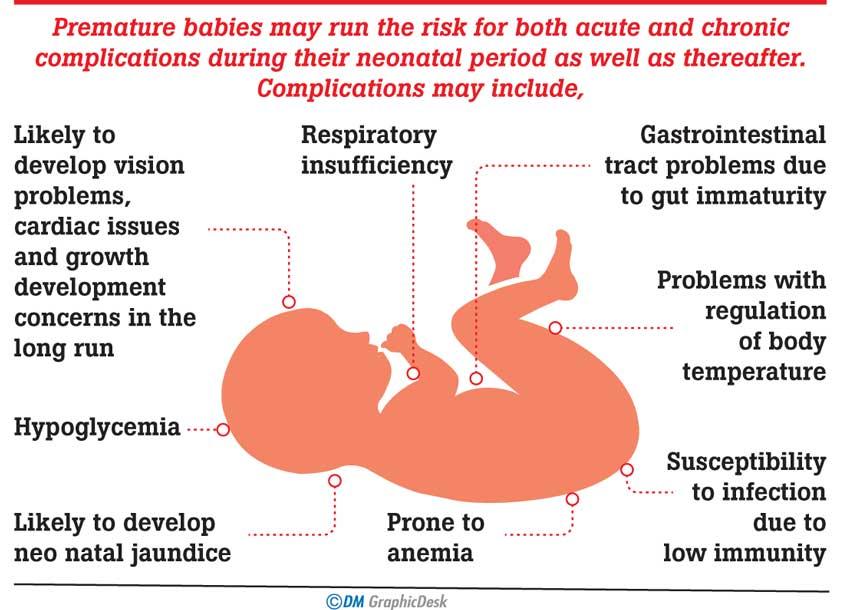Reply To:
Name - Reply Comment

 A healthy baby and a safe delivery are concerns that weigh in the minds of all parents to be. As such, the need to raise awareness on premature births and related complications is imperative. Speaking to Health Capsule, Consultant Obstetrician and Gynaecologist at the DHG Nawalapitiya, Dr. Kanishke Samaranayake says that early identification and mitigation of risk factors play a crucial role in limiting the risk of pre mature births. According to Dr. Samaranayake, in Sri Lanka, average premature birth rate is about 10-15 per 1000 live births, and globally ranges from 5-18%. Out of this, around 30% are associated with dribbling, 20% iatrogenic and rest due to other causes.
A healthy baby and a safe delivery are concerns that weigh in the minds of all parents to be. As such, the need to raise awareness on premature births and related complications is imperative. Speaking to Health Capsule, Consultant Obstetrician and Gynaecologist at the DHG Nawalapitiya, Dr. Kanishke Samaranayake says that early identification and mitigation of risk factors play a crucial role in limiting the risk of pre mature births. According to Dr. Samaranayake, in Sri Lanka, average premature birth rate is about 10-15 per 1000 live births, and globally ranges from 5-18%. Out of this, around 30% are associated with dribbling, 20% iatrogenic and rest due to other causes.
 Noting that a pregnancy and delivery of a healthy baby is a wonderful journey for every parent, Dr. Samaranayake explained that when a baby is conceived, for it to reach its full potential for growth and development, the gestation needs to be carried up to a term; approximately 37-40 weeks in humans. “If the delivery occurs prior to this duration, then we term it as a premature birth. Furthermore, depending on how far ahead from the expected delivery, it can be further classified into marginal prematurity or extreme prematurity, which are of both management and prognostic value” he said.
Noting that a pregnancy and delivery of a healthy baby is a wonderful journey for every parent, Dr. Samaranayake explained that when a baby is conceived, for it to reach its full potential for growth and development, the gestation needs to be carried up to a term; approximately 37-40 weeks in humans. “If the delivery occurs prior to this duration, then we term it as a premature birth. Furthermore, depending on how far ahead from the expected delivery, it can be further classified into marginal prematurity or extreme prematurity, which are of both management and prognostic value” he said.
“Preterm birth per se does not pose a significant risk to the physical health of the mother. But due to the consequential effects regarding the caretaking and special needs of the baby, it can have a significant impact on the mental and emotional health of the mother as well as the whole family. Mothers who give birth prematurely are more likely to face postpartum depression and psychosis and need careful monitoring, follow up and counselling if necessary” he said.
Risk factors leading to preterm birth
Preterm delivery is multifactorial with varying causative factors which can be maternal, fetal or iatrogenic. Maternal causes may include,
“When there are problems with the baby such as congenital anomalies or restricted growth, labour may have an early onset or even maybe induced since delivery is favourable when compared to the compromised growth environment within the mother’s uterus. Sometimes, babies may need to be delivered prematurely due to complications of the pregnancy such as hypertension or diabetes, when continuation of the pregnancy may adversely affect the maternal or fetal well-being” he added.
When preterm delivery is anticipated, steroids can be administered to the mother in order to ensure fetal lungs are matured

Long term effects and risk mitigation
Despite the risk for multiple health complications, with the advanced healthcare, specialized neonatologists, facilities and centers dedicated to premature baby units, preterm babies have excellent health prognosis in the long run. However preemies are still at the risk of facing some sequel as they grow, depending on the severity of the prematurity, antenatal complications and the degree of insult faced during their early life. These include,
Early identification of risk factors and taking necessary interventions are keys to mitigating the risks. “Previous history of a premature delivery can be identified in the first visit of a pregnant mother at an obstetric unit and can be planned to have prophylactic treatment if uterine problems or maternal genital tract infections are suspected. When preterm delivery is anticipated, steroids can be administered to the mother in order to ensure fetal lungs are matured. Delivery at a center equipped with facilities for premature baby care, can ensure that a preterm baby gets maximum attention and all problems are adequately addressed. Continuous assessment by obstetric, neonatal and field midwife can mitigate the incidence and effects of premature birth. Even though premature birth may seem scary to any parent to be, faith should be kept in the healthcare system dedicated for maternal and newborn health, so that both mother and the newborn will be provided the best of care for a happy parenthood” he added.